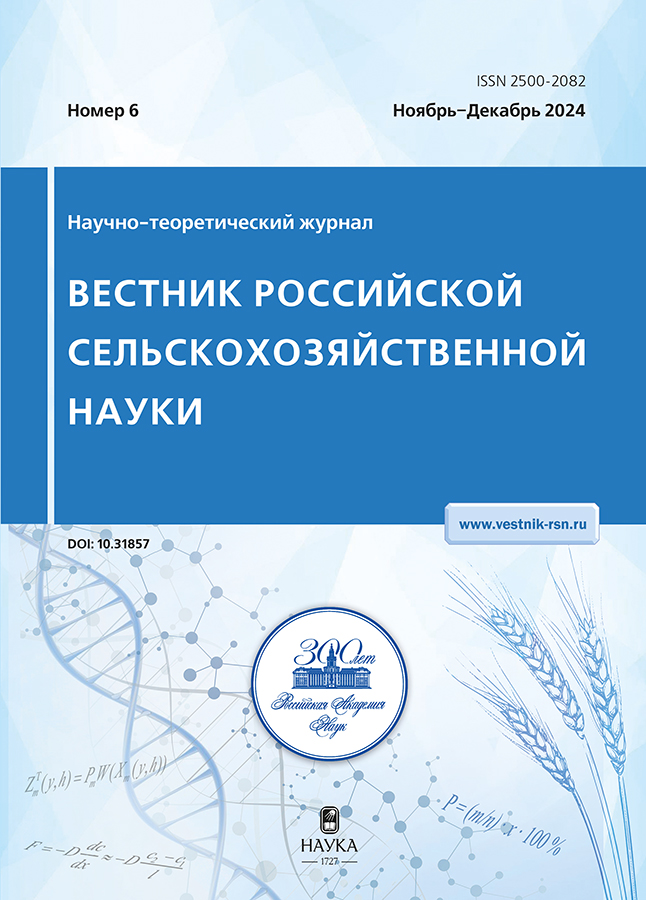Влияние препаратов на микробиологическую активность почвы и урожайность яровой пшеницы в зависимости от метеоусловий
- Авторы: Фомичёва Н.В.1, Смирнова Ю.Д.1, Рабинович Г.Ю.1
-
Учреждения:
- ФИЦ «Почвенный институт им. В.В. Докучаева»
- Выпуск: № 6 (2024)
- Страницы: 72-77
- Раздел: Земледелие
- URL: https://vietnamjournal.ru/2500-2082/article/view/659229
- DOI: https://doi.org/10.31857/S2500208224060164
- EDN: https://elibrary.ru/WSXSNL
- ID: 659229
Цитировать
Полный текст
Аннотация
В статье представлены результаты изучения влияния препаратов различной природы на микробиологическую активность почвы и урожайность яровой пшеницы при нестабильных погодных условиях. Яровую пшеницу выращивали на дерново-подзолистой легкосуглинистой почве. Годы проведения исследований отличались по влагообеспеченности: 2020 – избыточно влажный, 2021 – засушливый, 2022 – оптимальный. Использовали гуминовый препарат (ГП) и биопрепарат микробной природы (БП) для предпосевной обработки семян (20 л рабочего раствора ГП или БП 1%-й концентрации на 1 т семян), для двукратной некорневой обработки растений в фазах кущения и колошения (ГП – 1 л/га, БП – 3 л/га, норма расхода рабочих растворов – 300 л/га). В фазе кущения статистически значимо увеличилась численность доминирующих микроорганизмов в вариантах с обработкой семян препаратами: в 2020 году – на 25,4 (ГП) и 53,3% (БП), 2022 – 51,8 и 43,9% соответственно. В среднем за три года максимальный эффект от применения ГП наблюдали в засушливом 2021 году: увеличение численности микроорганизмов составило 59,3–94,2%, прибавка урожая – 13,0 и 13,9% соответственно для вариантов с предпосевной обработкой семян и некорневой растений, наибольшая прибавка получена от их совместного применения – 17,3%. БП был наиболее эффективен в год избыточного увлажнения – численность микроорганизмов увеличивалась на 50,8–84,7%, максимальная прибавка урожая пшеницы (15%) зафиксирована при обработке семян и растений.
Ключевые слова
Полный текст
Об авторах
Наталья Викторовна Фомичёва
ФИЦ «Почвенный институт им. В.В. Докучаева»
Автор, ответственный за переписку.
Email: vniimz@list.ru
кандидат биологических наук
Россия, МоскваЮлия Дмитриевна Смирнова
ФИЦ «Почвенный институт им. В.В. Докучаева»
Email: vniimz@list.ru
кандидат биологических наук
Россия, МоскваГалина Юрьевна Рабинович
ФИЦ «Почвенный институт им. В.В. Докучаева»
Email: vniimz@list.ru
доктор биологических наук, профессор
Россия, МоскваСписок литературы
- Безуглова О.С., Полиенко Е.А., Горовцев А.В., Лыхман В.А. Применение гуминового удобрения BIO-Don на черноземе обыкновенном под озимую пшеницу // Теоретическая и прикладная экология. 2015. № 1. С. 89–95.
- Бережная В.В., Клыков А.Г., Сидоренко М.Л., Быковская А.Н. Динамика содержания элементов питания и почвенных микроорганизмов в посевах яровой пшеницы с использованием бактериальных комплексов // Вестник КрасГАУ. 2020. № 2(155). С. 24–30. https://doi.org/10.36718/1819-4036-2020-2-24-30
- Дайнеко Н.М., Тимофеев С.Ф., Концевая И.И., Козел М.С. Влияния биопрепаратов на численность агрономически полезных групп микроорганизмов в посевах озимой ржи // Эпоха науки. 2022. № 29. С. 3–11.
- Дёмина Н.Ф. Влияние погодных условий на урожайность и качество зерна яровой пшеницы в лесостепи Среднего Поволжья // Аграрная наука Евро-Северо-Востока. 2022. № 23 (4). С. 433–440. https://doi.org/10.30766/2072-9081.2022.23.4.433-440
- Лыхман В.А., Полиенко Е.А., Дубинина М.Н. и др. Влияние гуминового препарата на продуктивность озимой пшеницы при возделывании на чернозёме обыкновенном // Известия Оренбургского государственного аграрного университета. 2018. № 5 (73). С. 60–63.
- Мосякина О.И., Лексикова В.В. Стимуляторы корнеобразования и регуляторы роста растений // Научный журнал молодых ученых. 2016. № 1(6). URL: https://cyberleninka.ru/article/n/stimulyatory-korneobrazovaniya-i-regulyatory-rosta-rasteniy (дата обращения: 08.04.2024).
- Муравьев А.А. Эффективность листовых подкормок на яровой пшенице // Инновации в АПК: проблемы и перспективы. 2020. № 1 (25). С. 154–161.
- Постников П.А., Попова В.В., Овчинников П.Ю., Тиханская Е.Л. Изменение погодных условий на Среднем Урале и их воздействие на урожайность яровой пшеницы // Достижения науки и техники АПК. 2023. Т. 37. № 3. С. 4–9. https://doi.org/10.53859/02352451_2023_37_3_4
- Рубец В.С., Ворончихина И.Н., Пыльнев В.В. и др. Влияние метеорологических условий на качество зерна яровой пшеницы (Triticum L.) // Известия Тимирязевской сельскохозяйственной академии. 2021. № 5. С. 89–108. https://doi.org/10.26897/0021-342X-2021-5-89-108
- Тимаков А.Г., Мамеев В.В., Павловская Н.Е. Влияние новых биологических препаратов на структуру урожая ярового ячменя в зависимости от метеоусловий // Агрохимический вестник. 2019. № 2. С. 53–57. https://doi.org/10.24411/0235-2516-2019-10028
- Garcia A.C., Santos L.A., Izquierdo F.G. et al. Vermicompost humic acids as an ecological pathway to protect rice plant against oxidative stress // Ecological Engineering. 2012. Vol. 47. P. 203–208. https://doi.org/10.1016/j.ecoleng.2012.06.011
- Fomicheva N.V., Rabinovich G.Yu. Technological line for processing animal waste. IOP Conference Series: Earth and Environmental Science. IV International Scientific Conference: «AGRITECH-IV-2020: Agribusiness, Environmental Engineering and Biotechnologies» 18–20 November 2020. Krasnoyarsk Science and Technology City Hall. Krasnoyarsk, Russian Federation. 677(2021) 052004. https://doi.org/10.1088/1755-1315/677/5/052004
- Marinho J., Silva S., Fonseca I. et al. Technological quality of wheat grains and flour as affected by nitrogen fertilization and weather conditions // Emirates Journal of Food and Agriculture. 2022. Vol. 34(12). PP. 997–1011. https://doi.org/10.9755/ejfa.2022.v34.i12.2977
- Wolejko E., Jablonska-Trypuc A., Wydro U. et al. Soil biological activity as an indicator of soil pollution with pesticides (A review) // Applied Soil Ecology. 2020. Vol. 147. PP. 103356. https://doi.org/ 10.1016/j.apsoil.2019.09.006
Дополнительные файлы










